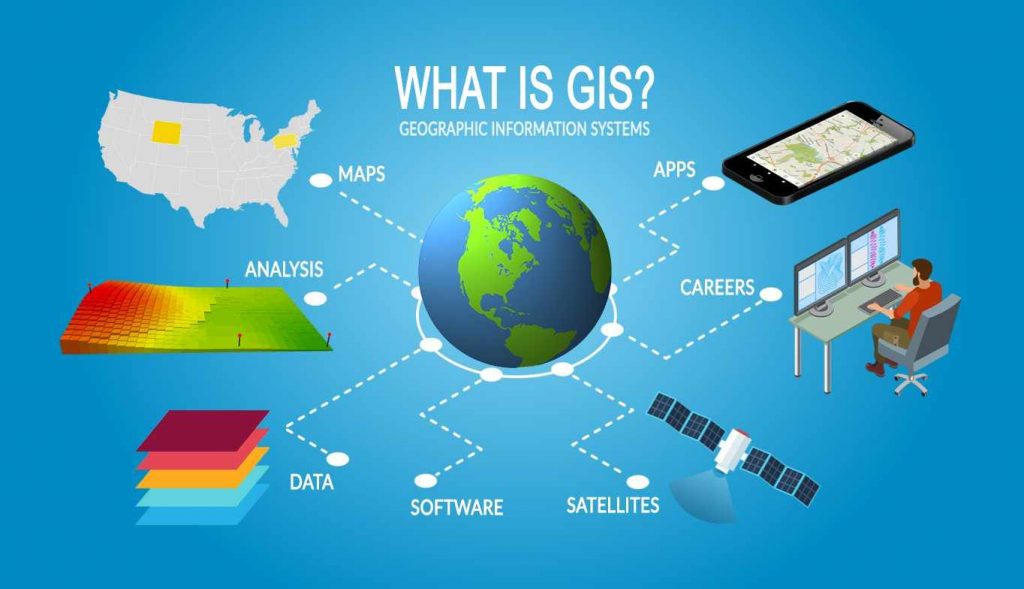What is GPS?
GPS stands for Global Positioning System by which anyone can always obtain the location and time information anywhere in the world. It is a system of earth-orbiting satellites which provides a precise location on earth’s surface in latitude/longitude coordinates. GPS is a powerful and widely used integrated tool(like in GNSS) that is used in Civil Engineering for collection of tabulated location data.
Segments of GPS
1. Space Segments – A number of GPS fly in a circular orbit around the earth at an altitude of approximately 20,000 km (four GPS satellites per one orbit) with a period of 12 hours. At least 6 satellites are always within line of sight from any location and these satellites are powered by solar cells.
2. Control Segments – Control Segment consists of the control station, monitor station, ground antenna. Control station maintains optimum GPS constellation. Monitor station checks the exact altitude, position, speed of orbiting satellite. Ground antennas communicate with GPS satellite. It is responsible for the proper functioning of all the operations of GPS.
3. User Segments – GPS receiver is composed of an antenna, receiver processor, and highly stable clock. At least 4 GPS satellites are required for calculating the exact position.
Application of GPS in Civil Engineering
1. Geodetic Control Survey– GPS is the system created and maintained by the United States. GLONASS is the Russian counterpart to GPS. These two systems combined called as Global Navigational Satellite System (GNSS) and continue to advance and improve its capabilities which has become a common tool for surveying and can perform geodetic control surveying in a very short time as compared to classical terrestrial survey methods.
2. Cadastral Survey– Cadastral surveying is the survey related to land boundaries and subdivisions and is used for boundary determination. With GPS, the cadastral survey provides very accurate results, and since the major work of the land is on real estate so it is considered as the most important of all the types of surveys. GPS receivers proved to be of high accuracy of the measurements and faster alternatives.
3. Photogrammetry, Remote sensing and surveying– GPS is integrated into photogrammetry and it increases the ease of spatial data acquisition. In Remote Sensing, GPS can be used to yield applications in various fields like environmental modelling, Disaster mitigation, mobile mapping, etc. GPS receivers provide very accurate data and are widely used in surveying.
4. Navigation– GPS helps in determining the ground position of an object and helps in the navigation to any location.
What is GIS?
A geographic information system (GIS) is a computer-based tool that examines spatial relationships, patterns and trends. It is used for capturing, storing, checking, and displaying data related to positions on Earth’s surface. It is an organized collection of computer hardware, software, geographical data to analyse and display all forms of referenced information. In GIS global reference system WGS 84 (World Geodetic System 1984) is used for geospatial information.
Components of GIS
1. Data: GIS stores location data as thematic layers and information about features. GIS data are of two types –
- Raster – It stores data in rows and columns. They can be discrete or continuous.
- Vectors – It is used to store spatial data which is comprised of lines or arcs.
2. Hardware – Hardware such as mobile phones, CPU runs GIS software, dual monitors, extra storage and graphic processing cards are must-haves too in GIS.
3. Software – ArcGIS and QGIS are the most commonly used desktop GIS software. There are other GIS software’s other than desktop GIS like GeoServer, MapServer, GeoTool, etc.
4. People – GIS users are technical specialists who design and maintain like managers, programmers, analysts, etc.
5. Method – The map can be created by automated raster to vector or can be done manually by scanned images.
Application of GIS in Civil Engineering
1. Remote Sensing – It gathers the information about an object ( It may be terrain, land, topography, hill etc.) without coming contact (physically) the object and this information or data is then used in GIS.
2. Transportation – GPS helps to review the existing infrastructure, involves surveys of roads. GIS integrates, manage, analyse and visualize the wide range of data sets.
3. Watershed analysis – Digital Elevation Models (DEMs) are a type of raster GIS layer and it is used in Watershed analysis to delineate watersheds and to derive features such as streams, stream network, catchment areas, basin etc.
4. Pollution monitoring – Different types of data can be integrated and correlated with GIS like chemical, physical, demographic. All this information can be analysed and elaborated in order to derive thematic cartography which is then integrated with health data.
5. Resource management – GIS in natural resource management is being used in analysing, organizing, managing and monitoring the natural hazards. It provides spatial data of the disasters which are indicated through the GIS-based map.
6. Terrain mapping and analysis – Terrain Analysis is the analysis and interpretation of topographic features such as slope, elevation, contour lines, upslope, downslope, etc. through GIS.
Softwares
- ArcGIS
- QGIS
- gvSIG
- Grass GIS
- SAGA GIS
- SuperGIS
- Map Window GIS
- IDRISI
- AutoCAD Map 3D
- Bentley Map
- ILWIS
And there are other wide ranges of software’s used.
Future GIS
GIS in future will present endless possibilities through innovative technology and approaches. It will also contribute to the production of new software products that provide users with remarkable conceptual design and efficient creation of 3D cities, landscapes, and buildings.
Big Data in Geoscience
The rise of big data and analytics has been one of the most significant shifts for businesses over recent years. With GIS data, analytics specialists can create visualizations, identify meaningful trends and helps in making predictions. Drones (UAV) is also going to improve the information that is available for mapping with GIS tools. In coming future GIS is essential to improving performance in self-driving cars and guiding drivers to their destinations as quickly, comfortably and safely as possible.



This material has help me in my studies, for the past two years. So I hereby appreciate this privilege. I really need assistance with regards my destination topic ” Investigation on the causes of pavement failure”